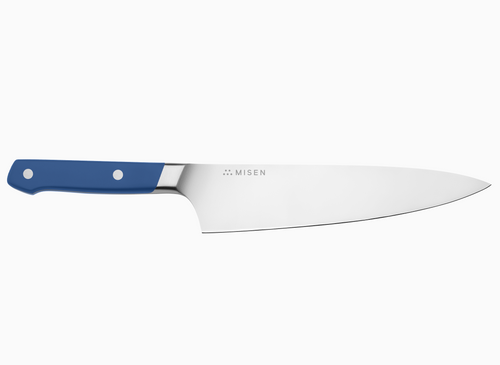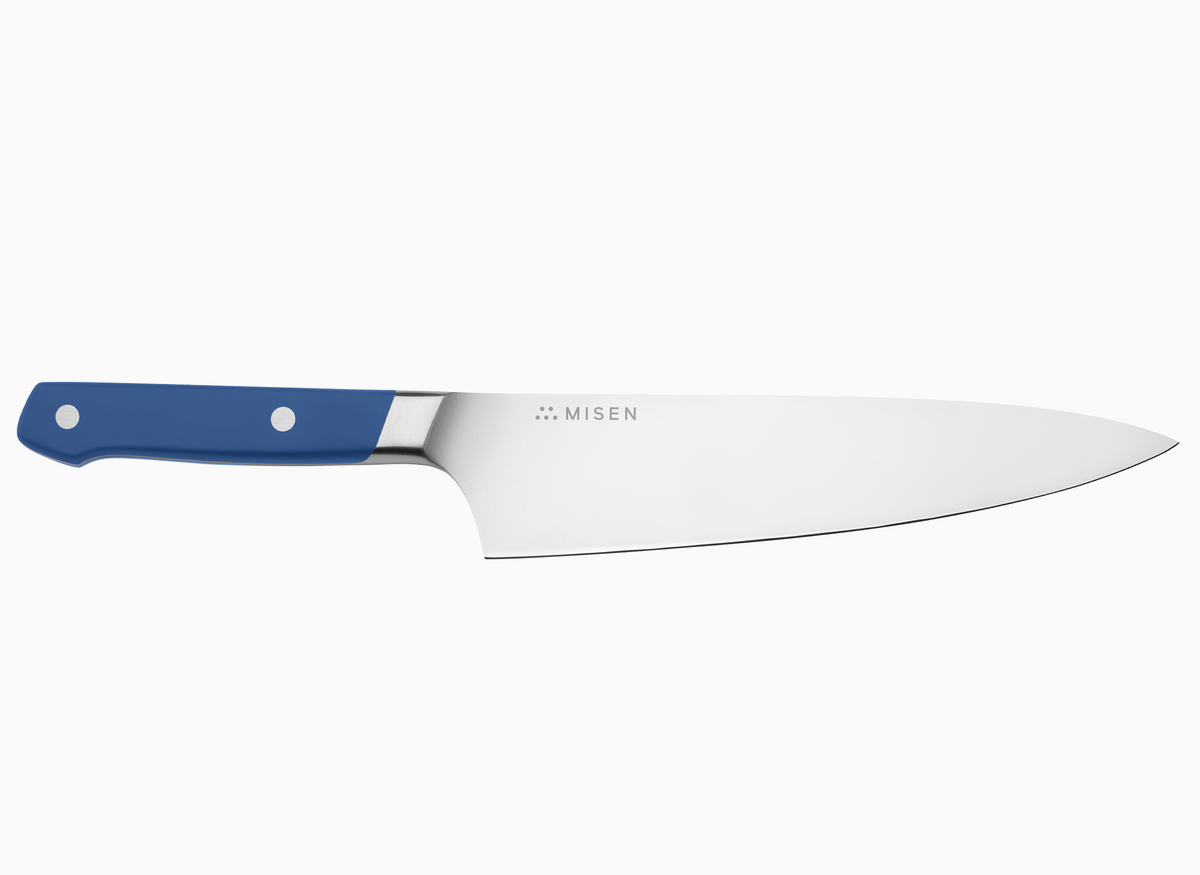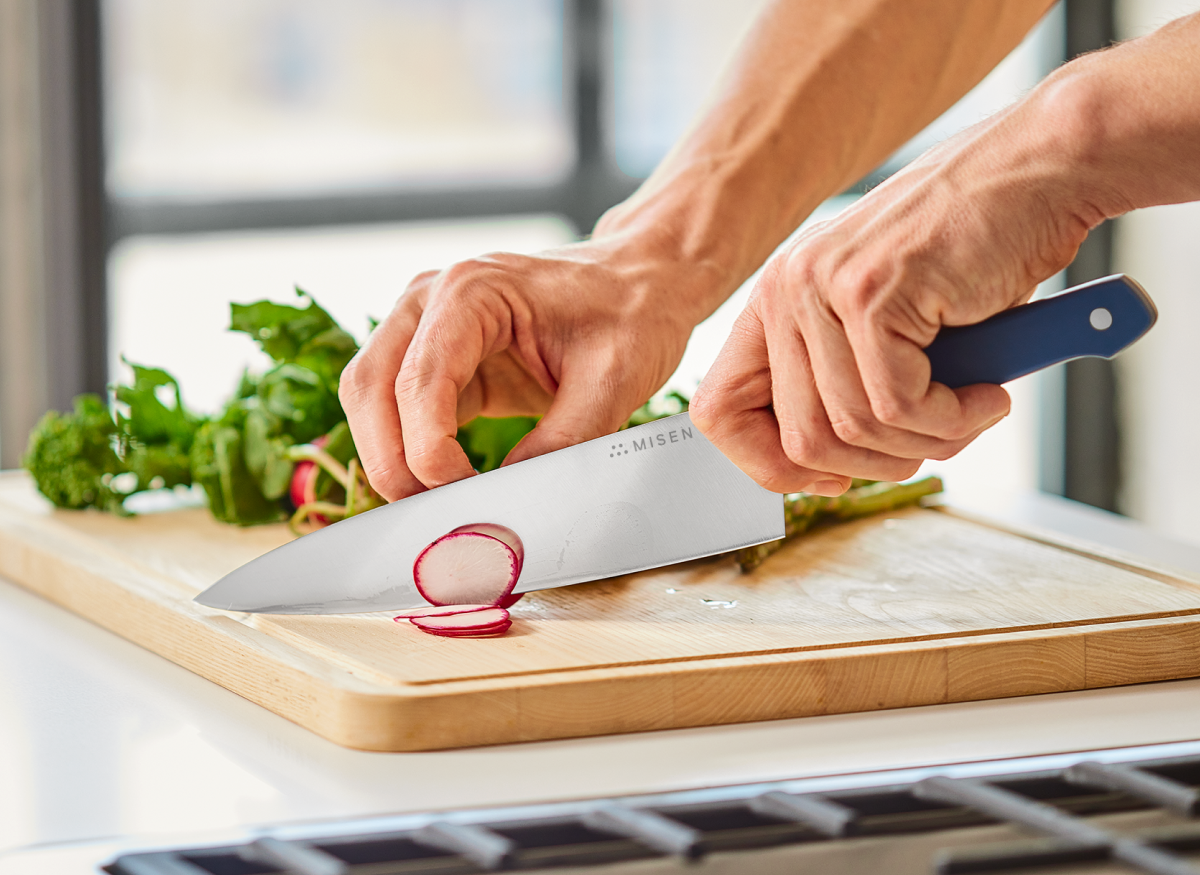How to Cut Eggplant in 4 Different Ways
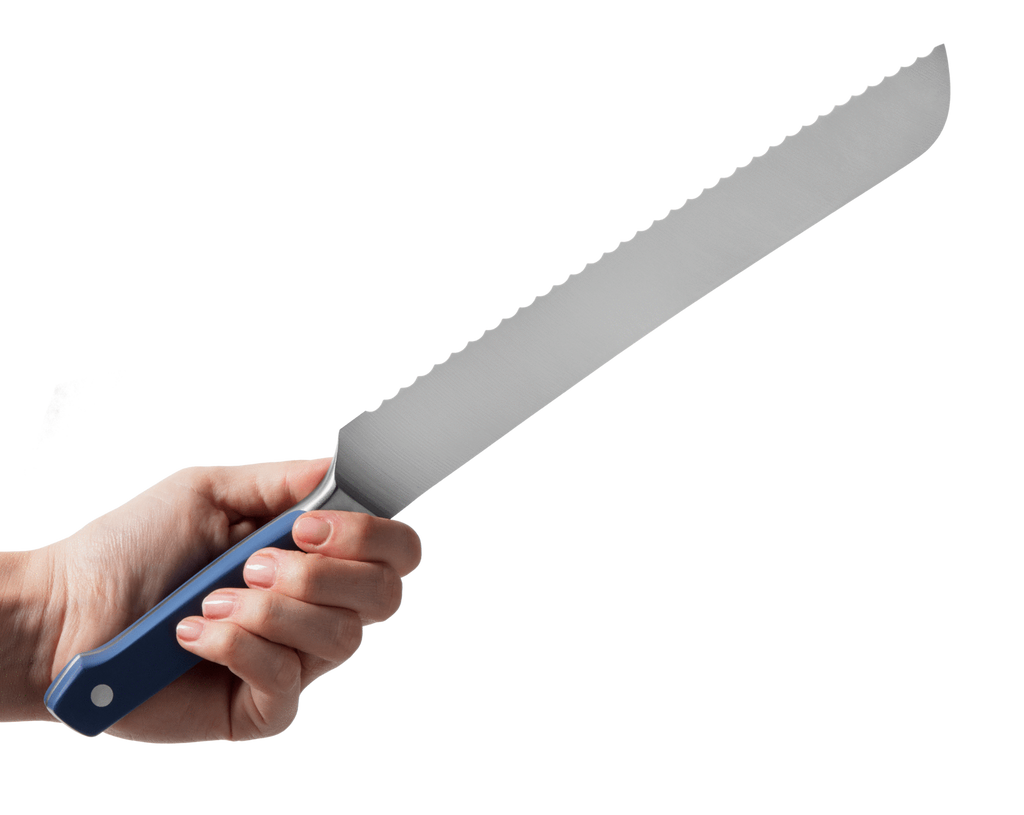 The “teeth” of a serrated knife are perfect for cutting into the skin of an eggplant without damaging the soft flesh underneath.
The “teeth” of a serrated knife are perfect for cutting into the skin of an eggplant without damaging the soft flesh underneath.
- Eggplant can be cut into almost any shape or size — with the most popular being planks, sticks, cubes, and rounds.
- To cut an eggplant, all you need is a stable cutting board and sharp kitchen knife, like a chef's knife, santoku, or serrated knife.
- Older or larger eggplants may be better eaten with their skin removed, which you can do with a vegetable peeler or paring knife.
A quick search for eggplant recipes reveals a lot of tasty possibilities — cheesy parmesans, creamy dips, roasted entrées. The advantage of this popular nightshade fruit is that it takes on flavor very easily. And depending on how it’s cooked, it can either take on a firm, meat-like texture or a soft, creamy consistency.
Before cooking, however, the flesh of an eggplant starts out more like foam or a dense sponge. Not exactly appetizing, but it does make raw eggplants extremely easy to cut into any shape or size.
In this post, we'll go over the basic kitchen tools needed and steps for how to cut an eggplant no matter what dish you plan to prepare.
Tools Needed to Cut an Eggplant
To start, you need two kitchen essentials — a sharp knife and a stable cutting board. The best knives to cut an eggplant are a chef's knife, a santoku, or a serrated knife.
The blades of these knives — a chef knife being 7-8 inches, a santoku being 6-7 inches, and a serrated knife being 8-10 inches — make them long enough to tackle most eggplant.
Although there are a number of eggplant varieties available in the grocery store, the average American eggplant, or globe eggplant, is about 8 inches long and 5 inches wide. Other common varieties, like Italian, Asian, or graffiti eggplant, typically range from 7-9 inches long and are slightly thinner.
So whether you prefer the straight edge of a chefs knife or santoku, or the points of a serrated knife, any of these three pieces of cutlery are a good choice for cutting eggplant. Serrated knives are particularly good for sawing into soft or cooked eggplant. Their toothlike edge is perfect for “biting” into food with firm exteriors and soft interiors, like crusty bread, cake, tomatoes, and yes, eggplant.
A stable cutting board is essential when cutting any type of food. The best ones are made of wood because they’re sturdier and longer lasting than cutting boards made from other materials.
Wood is also a naturally self-healing material — the wood fibers return to their compressed state after being cut, which makes the board more resistant to bacteria, dirt, and stains. Wood cutting boards also usually come at a good thickness and weight to stay stable on your kitchen counter.
With your knife of choice and a good wood cutting board, you’re ready to cut some eggplant.
Before Making Your First Slice
 Look for an eggplant with smooth, unblemished skin, a firm feel, and a bright green stem.
Look for an eggplant with smooth, unblemished skin, a firm feel, and a bright green stem.
Choosing a good eggplant is rather intuitive. Skin that has a smooth deep purple color and tight, glossy shine, are your best bets. As are ones with no blemishes and a firm feel that springs back a bit when pressed — not as crisp as an apple but not as soft as a ripe peach.
One telling feature to look out for is the eggplant’s stem. It should be a nice and healthy green, and clear of brown spots, mushy parts, or signs of mold.
For fruit with the least bitterness, stick to small to medium size eggplant. These have thinner skin, tender flesh, and fewer seeds, which is where the bitterness comes from.
Plus, a smaller eggplant usually indicates the fruit was harvested at a younger age. So unless the recipe specifically calls for a larger eggplant, it’s best to opt for several smaller ones instead.
While eggplants in their prime just need a rinse in cold running water and quick pat dry with paper towels, older or larger eggplants usually require their skin to be removed before you begin slicing. A sharp paring knife or vegetable peeler are great tools for this task.
Cut about half an inch off both the top and bottom of the eggplant, which leaves a nice long surface that’s naturally easy to peel. Stand the eggplant on its now flat bottom and position the peeler or paring knife at the top, making a tiny incision just beneath the skin.
Then carefully draw the peeler or paring knife straight down the length of the eggplant, taking off a strip of eggplant skin. Rotate the eggplant and repeat until all the skin is gone.
Some people also recommend salting their eggplants after cutting them (before cooking), which is simply adding salt to a cut eggplant and allowing it to sit in a colander for about an hour. This is supposed to reduce the bitterness and oil absorption. However, others find the added step doesn't really produce the intended effect and only lengthens preparation time.
Whether you choose to have eggplant small or large, skin on or skin off, now that it's washed and prepped, you can easily cut it into your choice of planks, sticks, cubes, or rounds.
How to Cut Eggplant Into Planks (Large Slices)
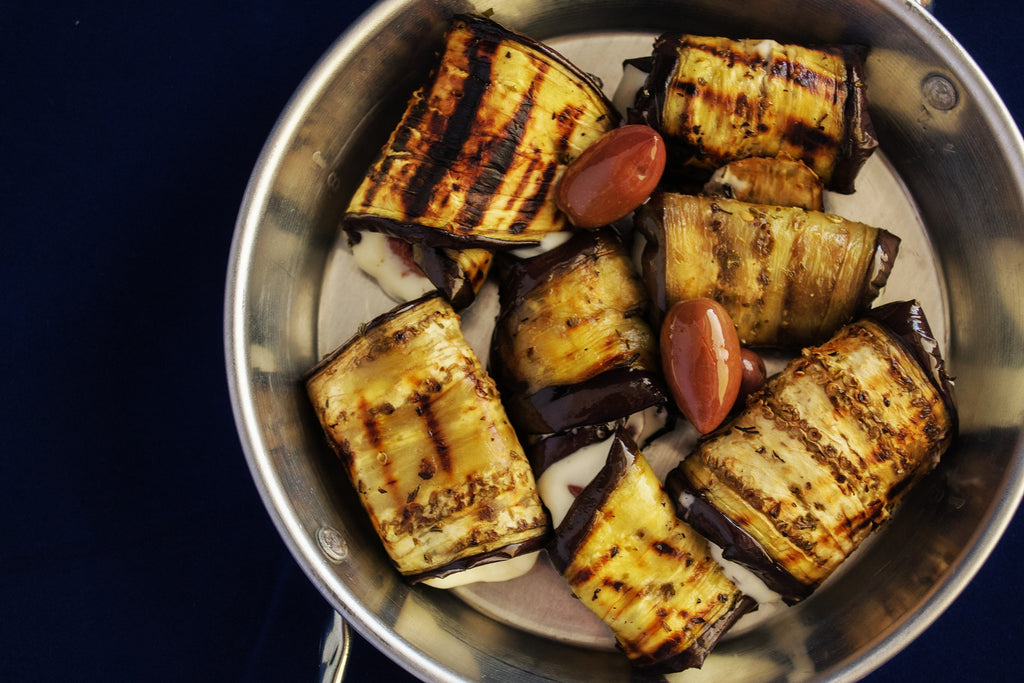 Eggplants that’s been cut into planks can be used in place of long pasta sheets in lasagna or as an outer roll for savory stuffing.
Eggplants that’s been cut into planks can be used in place of long pasta sheets in lasagna or as an outer roll for savory stuffing.
This preparation is perfect for roasting and baking, as in lasagnas, eggplant parmesans, and rollatini.
A number of Italian-inspired recipes can be made with large slices of eggplant in place of pasta sheets. Eggplant planks are also the starting point for creating sticks and cubes.
If you choose to peel your eggplant, do that step first. Then slice off about half an inch from both ends of the eggplant. Lay the eggplant on its side across the center of the cutting board with the bottom end closer to you. Then positioning your knife at the top of the eggplant, about half an inch in from one side, create a long straight slice down the length of the fruit. Repeat this until you have a pile of long eggplant slices.
If the eggplant is on the shorter side, an alternative is to cut off the ends and stand it on its flat bottom. Holding the fruit firmly from the top, start slicing it into long planks, going from top to bottom. Take care using this method, as it’s easy to lose control and slip when making the long cut.
How to Cut Eggplant Into Cubes
Cubes are perfect for sautés, salads, tacos, and pastas.
Cubed eggplant softens quickly, takes on flavor easily, and mixes with almost any other ingredient. To turn an eggplant into cubes, start by slicing off the ends and cutting the remaining body into half inch thick planks.
Pile the planks on top of one another (group them in similar sizes for larger eggplants), and slice into half inch thick sticks. If possible, keep the slices still assembled in plank form. Repeat until all the eggplant planks have been cut into sticks.
Then carefully position the plank along the length of the cutting board and cut the sticks crosswise at half-inch intervals. Do this for the remaining sticks, and when finished, you should have a neat pile of cubed eggplant ready to cook.
How to Cut Eggplant Into Rounds
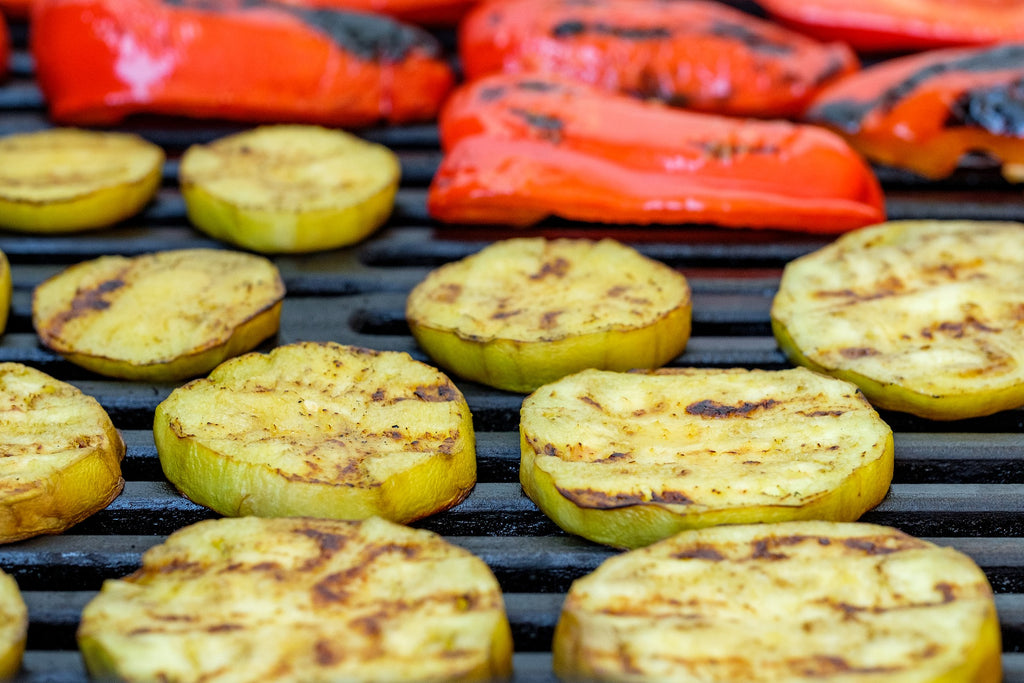 Eggplant rounds are the easiest way to cut an eggplant, thanks to the fruit’s naturally long, circular shape.
Eggplant rounds are the easiest way to cut an eggplant, thanks to the fruit’s naturally long, circular shape.
This cut works great in sandwiches or as a base layer for various toppings.
The tubular shape of eggplant lends itself perfectly to round, medallion-shaped pieces. Firmly hold the eggplant down on its side along the length of the cutting board with your non-dominant hand (the hand not holding any cutlery). Make sure to curl your fingers in, so the nails are angled down toward the fruit to protect them from any accidental cuts.
Then take your knife of choice — chef's knife, santoku, or serrated knife — and slice off the top of the eggplant, about half an inch under the stem. Continue slicing the eggplant at the desired thickness. Note that eggplant will lose moisture and shrink when cooked, so it’s best to not create extremely thin slices.
Once the entire length is sliced, discard the top and bottom ends, which tend to be tough and bitter, and proceed to cook your eggplant.
How to Cut Eggplant Into Sticks
This cut works well with crunchy veggie fries, tempura, and Chinese stir-fries.
An eggplant can be cut into sticks by first slicing it into rounds (for shorter sticks) or planks (for longer sticks). It’s up to personal preference, as long as the pieces are roughly the same size to facilitate even cooking.
Lay the eggplant round or plank flat on the cutting board, and slice it into sticks of a similar width. For example, if the round or plank is 1-inch thick, slice sticks of 1-inch thicknesses, as well. Do this for the remaining eggplant pieces.
To create thicker wedges, slice off the ends and cut the entire eggplant in half lengthwise. Place both eggplant halves flat-side down. Then, holding one half firmly on the cutting board, position the blade at the top, about an inch from the side, and slice diagonally toward the bottom center. Move the sliced wedge aside, and repeat an inch from the first cut. Continue until the entire half is sliced and proceed to the second half.
Enjoying Eggplant
There are so many ways to cut and cook eggplant. Their spongy flesh makes the fruit easy to slice when raw and very absorbent to any flavor when cooked. Whether you’ve always eaten eggplant or are just getting started, the tips above will help you understand how to cut eggplant and enjoy it in an array of new dishes.

